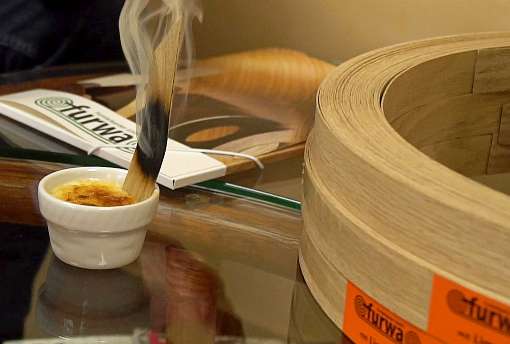09.05.2019
“Thanks to our production method, not only the “thick, continuously end-matched veneer edge banding” but also the “non-woven and thinly ground with ready-varnished surface” finish are easy to achieve. In addition, we also produce special flame resistant, translucent veneers for lampshades; the result is a decidedly varied range of possible applications for the home or for commercial use”, said the company's managing director Roland Reigbert, who further explained: “However, the user must test the usability and workability of the fire resistant edgings, thick veneer edgings and veneer wraps, including with regard to their response to fire. This also applies to other areas of use, such as on lampshades. The users' own tests ensure that the veneer edge bandings are perfectly suitable for the respective intended use”. The Secretary of Initiative Furnier + Natur (IFN), Ursula Geismann, added finally: “Exciting new developments were and are an important part of the veneer industry. Flame resistant edge banding such as this is an important example of the industry's innovative power”. IFN/DS
How veneer is made: Veneer is obtained from the wood of selected trees, which are mainly grown in sustainably managed forests. The tree species used the most are Maple, Beech, Oak, Ash and Walnut from domestic, European, and in the case of Oak, Maple and Walnut, from American forests too. If the right tree has been found it is peeled, sliced or sawn. This produces sheets of wood, which are around 0.45 to 6 millimetres thick. These are dried, stacked according to quality and grade, cut and are put together to form a deck. These veneer decks are then bonded and pressed onto substrate materials such as solid wood laminboards, particleboards, MDF panels, multiplex panels or plywood.
Initiative Furnier + Natur (IFN)
Initiative Furnier + Natur (IFN) e.V. was founded in 1996 by the German veneer industry and its partners. Based in Bad Honnef, the purpose of the association is to promote veneer as a material. It is funded and supported by European companies in the veneer industry, trade and the veneer processing industry as well as professional associations of the timber industry.
Image: FURWA's Limartec thick veneer edge banding is flame resistant and is therefore suitable for many different uses. In fire tests, it chars and extinguishes immediately. Photo: IFN/FURWA Furnierkanten GmbH
Further information on the topic of veneer is available at www.furnier.de or at www.furniergeschichten.de.
An innovative product: Flame resistant veneer edge banding
Bad Honnef/Walkertshofen: FURWA Furnierkanten GmbH in Walkertshofen now has flame resistant veneer edge banding in its product range. The innovative veneer edge banding is produced as standard veneer edging, thick veneer edging and wrapping veneer. It is sold in the form of rolls of veneer impregnated with flame retardant. The veneer is produced by Interior Proman and is marketed under the name Limartec.“Thanks to our production method, not only the “thick, continuously end-matched veneer edge banding” but also the “non-woven and thinly ground with ready-varnished surface” finish are easy to achieve. In addition, we also produce special flame resistant, translucent veneers for lampshades; the result is a decidedly varied range of possible applications for the home or for commercial use”, said the company's managing director Roland Reigbert, who further explained: “However, the user must test the usability and workability of the fire resistant edgings, thick veneer edgings and veneer wraps, including with regard to their response to fire. This also applies to other areas of use, such as on lampshades. The users' own tests ensure that the veneer edge bandings are perfectly suitable for the respective intended use”. The Secretary of Initiative Furnier + Natur (IFN), Ursula Geismann, added finally: “Exciting new developments were and are an important part of the veneer industry. Flame resistant edge banding such as this is an important example of the industry's innovative power”. IFN/DS
How veneer is made: Veneer is obtained from the wood of selected trees, which are mainly grown in sustainably managed forests. The tree species used the most are Maple, Beech, Oak, Ash and Walnut from domestic, European, and in the case of Oak, Maple and Walnut, from American forests too. If the right tree has been found it is peeled, sliced or sawn. This produces sheets of wood, which are around 0.45 to 6 millimetres thick. These are dried, stacked according to quality and grade, cut and are put together to form a deck. These veneer decks are then bonded and pressed onto substrate materials such as solid wood laminboards, particleboards, MDF panels, multiplex panels or plywood.
Initiative Furnier + Natur (IFN)
Initiative Furnier + Natur (IFN) e.V. was founded in 1996 by the German veneer industry and its partners. Based in Bad Honnef, the purpose of the association is to promote veneer as a material. It is funded and supported by European companies in the veneer industry, trade and the veneer processing industry as well as professional associations of the timber industry.
Image: FURWA's Limartec thick veneer edge banding is flame resistant and is therefore suitable for many different uses. In fire tests, it chars and extinguishes immediately. Photo: IFN/FURWA Furnierkanten GmbH
Further information on the topic of veneer is available at www.furnier.de or at www.furniergeschichten.de.
